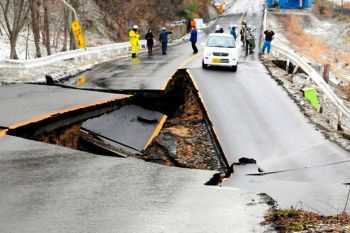
Publisher:
Bonnie King
CONTACT:
Newsroom@Salem-news.com
Advertising:
Adsales@Salem-news.com

~Truth~
~Justice~
~Peace~
TJP
Dec-07-2013 12:00

 TweetFollow @OregonNews
TweetFollow @OregonNews
Scientists Calculate Friction of Japan's 9.0 Earthquake in 2011
Salem-News.comScientists hope to repeat the experiment with other earthquakes, although the logistics of such a study are daunting – requiring a large earthquake with lots of slip...
 poleshift.ning.com |
(CORVALLIS, OR) - An international team of scientists that installed a borehole temperature observatory following the 2011 Tohoku-Oki earthquake in Japan has been able to measure the “frictional heat” generated during the rupture of the fault – an amount the researchers say was smaller than expected, which means the fault is more slippery than previously thought.
It is the first time scientists have been able to use precise temperature measurements to calculate the friction dynamics of fault slip.
Results of the study are being published this week in the journal Science.
“This gives us some unprecedented insights into how earthquakes actually work,” said Robert Harris, a geophysicist at Oregon State University and co-author on the Science article. “No one really knows how much frictional resistance there is to slip and for the first time, this gives us some idea.
“The project itself was an engineering feat and an amazing one at that,” added Harris, who is a professor in the College of Earth, Ocean, and Atmospheric Sciences at Oregon State. “To reach the fault, the team had to drill through 800 meters of the seafloor – at a depth of nearly 7,000 meters below the ocean’s surface. It pushed the limits of that technology as far as they can go.”
The study was funded by the Japan Agency for Marine-Earth Science and Technology, the Integrated Ocean Drilling Program, the National Science Foundation, and the Gordon and Betty Moore Foundation.
Sixteen months after the magnitude 9.0 Tohoku-Oki earthquake, the scientists installed the borehole observatory in a section of the fault where the slippage between one section of rock and the adjacent one was a staggering 50 meters. It was that huge slip in the fault that triggered the tsunami that killed thousands of people and devastated the northern coast of Japan.
After nine months of operation, the research team successfully retrieved 55 precise temperature-sensing data loggers that extended below the seafloor through the fault zone – the deepest of which was about 820 meters below the seafloor.
Evaluation of the data showed an anomaly of 0.31 degrees (Celsius) with surrounding temperatures at the boundary of the plate’s fault. When tectonic plates rub against each other, the frictional resistance to slip creates heat. By measuring changes to the background temperature field, they can calculate how much heat, or energy, was generated at the time of the earthquake.
“This is data that we’ve never had before,” Harris said. “It will be helpful in understanding the dynamics of earthquakes in the future.”
The scientists say this 0.31 temperature anomaly corresponds to 27 million joules, or 27 megajoules, per square meter of dissipated energy during the earthquake. A joule is the amount of energy required to produce one watt of power for one second. The “friction coefficient,” or the resistance to relative motion between the blocks, was surprisingly small at 0.08, the scientists point out.
“One way to look at the friction of these big blocks is to compare them to cross-country skis on snow,” Harris said. “At rest, the skis stick to the snow and it takes a certain amount of force to make them slide. Once you do, the ski’s movement generates heat and it takes much less force to continue the movement.
“The same thing happens with an earthquake,” he added. “This is the first time we’ve been able to calculate how much frictional resistance to slip there is. This has never been done before in nature – just in the laboratory.”
Harris said the scientists hope to repeat the experiment with other earthquakes, although the logistics of such a study are daunting – requiring a large earthquake with lots of slip, the ability to quickly drill a deep borehole and then monitoring the thermal signal. Similar experiments with other earthquakes will allow the scientists to better understand the hazards associated with large earthquakes.
“This was a major accomplishment,” he added, “but there is still a lot we don’t yet know.”
About the OSU College of Earth, Ocean, and Atmospheric Sciences: CEOAS is internationally recognized for its faculty, research and facilities, including state-of-the-art computing infrastructure to support earth/ocean/atmosphere observation and prediction. The college is a leader in the study of the Earth as an integrated system, providing scientific understanding to complex environmental challenges.
 |
 |
 |
Articles for December 6, 2013 | Articles for December 7, 2013 | Articles for December 8, 2013




Quick Links
DINING
Willamette UniversityGoudy Commons Cafe
Dine on the Queen
Willamette Queen Sternwheeler
MUST SEE SALEM
Oregon Capitol ToursCapitol History Gateway
Willamette River Ride
Willamette Queen Sternwheeler
Historic Home Tours:
Deepwood Museum
The Bush House
Gaiety Hollow Garden
AUCTIONS - APPRAISALS
Auction Masters & AppraisalsCONSTRUCTION SERVICES
Roofing and ContractingSheridan, Ore.
ONLINE SHOPPING
Special Occasion DressesAdvertise with Salem-News
Contact:AdSales@Salem-News.com

Terms of Service | Privacy Policy
All comments and messages are approved by people and self promotional links or unacceptable comments are denied.
[Return to Top]
©2025 Salem-News.com. All opinions expressed in this article are those of the author and do not necessarily reflect those of Salem-News.com.